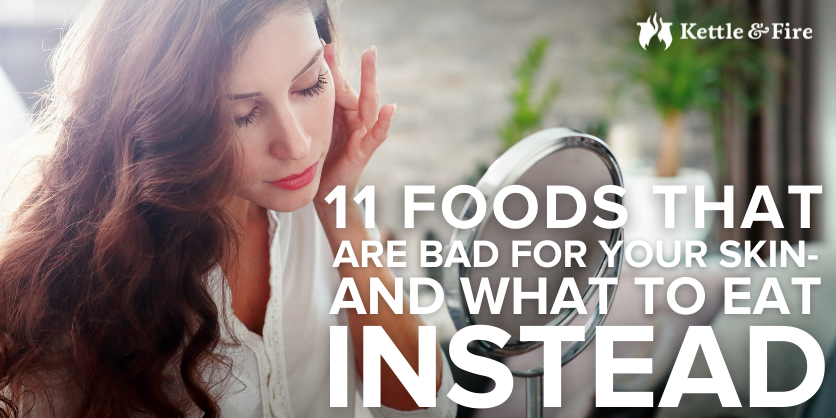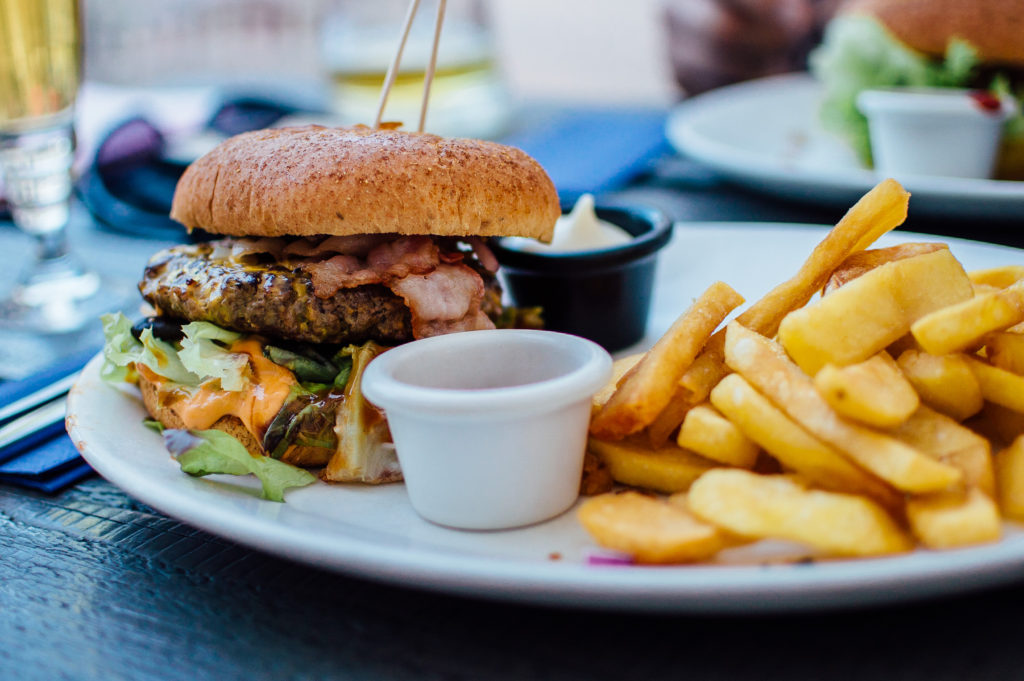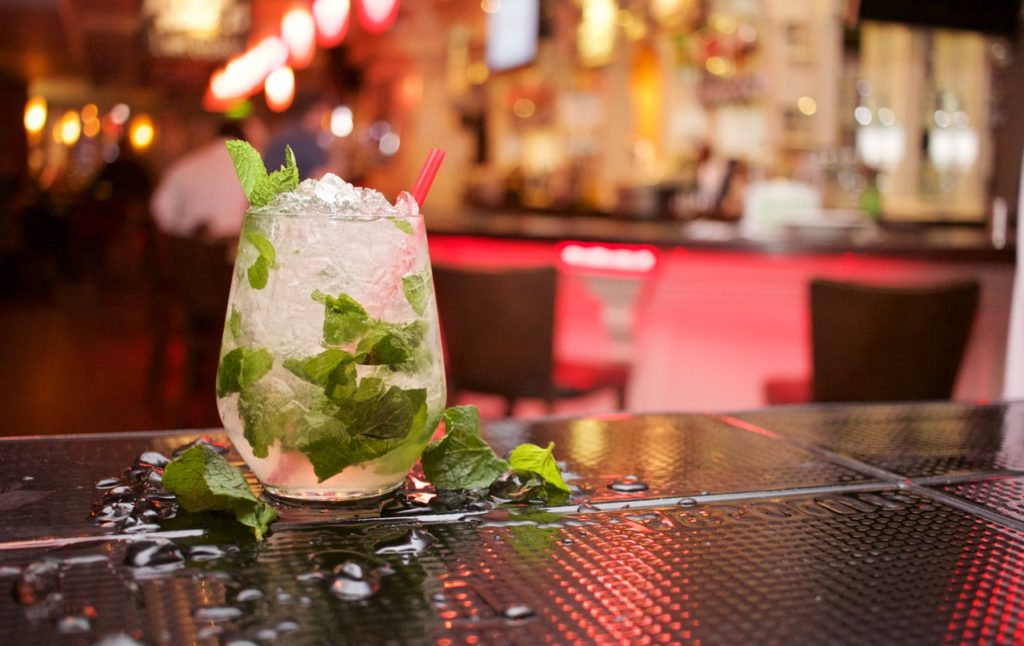11 Foods That Are Bad For Your Skin

AND WHAT TO EAT INSTEAD
Acne and other skin conditions can destroy your confidence, leaving you with a feeling of helplessness – especially wen you don’t even know what’s causing it! Ughhh, frustrating.
While the underlying causes of skin conditions are different for each person, the right foods can play a big role in your overall skin health.
The Link Between Skin and Nutrition
“Clear skin is an inside job.” Our outsides can be a direct reflection of internal health – in particular, the liver and digestive system.
Our bodies are always working hard to eliminate toxins. So when the liver isn’t up to snuff, toxins begin to filter through other organs that serve as “backup” for your liver. And this includes our skin.
As toxins are eliminated through the skin, they may cause rashes, pimples, blackheads, and other unsightly conditions.
Now, here’s where diet comes in:
Every food we eat has the potential to benefit or harm our skin.
For example, fruits and veggies containing antioxidant vitamins aid in the production of collagen (the protein that keeps skin smooth and supple), and may help the liver naturally detoxify to prevent breakouts.
On the other hand, refined sugar can break down collagen by cross-linking with other collagen fibers through a process known as glycation, which is known to form molecules that contribute to aging (more on that in a moment).
With that said, let’s dive into the foods that don’t promote skin health — and why.
Here are eleven foods that could be bad for your skin, and what to eat instead.
11 Foods That May Be Bad For Your Skin (And What to Eat Instead)
Refined Carbohydrates

Why They’re Bad
If our skin has one nemesis, it would be refined carbohydrates. “Refined carbs” refer to processed sugar and processed flour, which break down into sugar.
Reason #1: Refined Carbs Deplete Healthy Gut Bacteria
Refined carbs have poor nutritional value. But they do feed on something: the bad bacteria in our gut. Sugar acts as a food source for bad bacteria, which gives it a chance to feast, flourish, and crowd out the good bacteria. And an overgrowth of bad bacteria has been linked to some digestive conditions.
Since acne is a bacterial condition, it makes sense that breakouts can be linked to bacterial imbalances. This is why many skin-supportive regimens begin with replenishing healthy gut bacteria by eating probiotic foods such as sauerkraut, and taking a probiotic supplement.
Reason #2: Refined Carbs Increase Oil Production
As if robbing your healthy gut bacteria isn’t enough, refined sugar may also cause the body to produce more oil and clog pores.
When we eat refined sugar, our bodies release the hormone insulin, which regulates your blood sugar by transporting sugar into our cells. Now, because refined sugar digests rapidly, the body must release large amounts of insulin to “keep up” with bringing sugar into cells just as quickly as it’s being digested.
Research shows these rapid insulin spikes can trigger production of sebum (oil), which can clog pores and form pimples, whiteheads, and blackheads.
And in case we need one more reason to nix sugar from our diet…
Reason #3: Refined Carbs Age Your Skin
Processed sugar ages skin — literally — by creating molecules called AGEs (advanced glycation end products). This process is known as glycation, a major factor in premature aging.
You see, when we digest refined carbohydrates, the sugar molecules become “co-dependent” and attach themselves to proteins such as collagen. When sugar molecules latch onto collagen molecules, together, they form brand new molecules: advanced glycation endproducts, or AGEs. Unfortunately, the body can’t break this bond, and those collagen proteins that form smooth, youthful skin become lost forever.
When it comes to refined sugar, simply cutting table sugar out of your diet isn’t enough: it’s also important to read food labels because refined sugar goes by many names, including: high fructose corn syrup, table sugar, cane sugar, and glucose-fructose (just to name a few).
And let’s not forget that refined carbohydrates include white flour — so we’re talking muffins, pastries, pasta, pizza crust, and white bread as well. Processed sugar and flour hide in the majority of boxed, packaged and store bought foods, including “healthy” versions of processed foods, such as organic ketchup. This is why it’s crucial to read food labels when it comes to maintaining skin health. It’s best to try and avoid processed foods altogether.
What to Replace It with (And Why It Supports Skin Health)
Natural sweeteners such as raw honey, maple syrup, apple sauce, green leaf stevia, and coconut nectar are low–glycemic sweeteners, meaning they may have less of an impact on blood sugar levels and are less likely to trigger skin breakouts when used in small amounts.
For people who suffer from a chronic skin condition, such as eczema or psoriasis, it’s best to avoid the sugar altogether, including the natural sources. However, green leaf stevia can still be used because it doesn’t interfere with normal blood sugar levels.
And what about those no-calorie sweeteners, you ask? Once thought to be the better alternative to refined sugar, studies show artificial sweeteners such as aspartame and sucralose may actually cause sugar cravings and raise blood sugar levels, the exact same way processed carbs do. Yikes. Best to avoid those bad boys, too.
Dairy

Why it’s Bad
Dairy is a common skin trigger for a few reasons:
Reason #1: It’s a pro-inflammatory food.
Pro-inflammatory foods can aggravate or worsen existing inflammatory skin conditions, such as acne, rashes, and eczema.
Reason #2: Growth hormones and antibiotics are often found in conventional dairy products.
These hormones may interfere with the body’s natural hormonal balance. In particular, excess estrogen (the female growth hormone) in your system is suspected to contribute to hormonal cystic acne — however, there’s a lack of research to confirm the link between acne and estrogen dominance.
Reason #3: Dairy is a common food sensitivity.
It’s estimated that 75% of the world population and 25% of the US population is intolerant to lactose, the sugar found in dairy — and most people aren’t even aware they’re sensitive.
Repeatedly eating a food that the body has difficulty processing can lead to more chronic digestive conditions. Food allergies and sensitivities may also trigger an inflammatory response throughout the entire body. As you may have guessed, when our bodies experiences inflammation, it can trigger inflammatory skin condition flare-ups.
It’s also worth noting that some forms of alternative medicine view dairy as a “clogging” food that congests the skin and liver.
What to Replace it With (And Why it Supports Skin Health)
Replace dairy with unsweetened nut milk, such as coconut milk, almond milk, or cashew milk. These alternatives are hormone, antibiotic, and lactose-free, and may have less of a negative impact on the liver and digestion.
Soy

Why it’s Bad
Soy was once a popular (and even somewhat trendy) vegan alternative to dairy, but it’s now more popular as a food sensitivity— likely because today, nearly 90% of the world’s soy crops are genetically engineered.
Soy also contains phytoestrogens, which mimic the hormone estrogen when absorbed in the body. Similar to the growth hormones found in dairy, phytoestrogens can also disrupt hormonal balance, and lead to excess estrogen in the body if a person isn’t deficient in estrogen. And, as we covered above, estrogen dominance may be associated with hormonal cystic acne.
What to Replace it With (And Why it Supports Skin Health)
Choose nut milk over soy milk, and replace tofu with beans or organic, grass-fed meat if you include animal products in your diet.
(Side Note: If you’re a sushi lover, don’t worry— you can replace soy sauce with coconut aminos, which can be found at any health food store.)
All of these soy-free options are good for skin because they’re often less processed (which means they’re higher in nutrients), free from phytoestrogens, and are less likely to be food sensitivities.
Fast Food

Why it’s Bad
This one probably won’t come as ashock: fast food items are often deep-fried in refined vegetable oils, such as canola oil, safflower, and peanut oil, and loaded with trans-fats. While vegetable oils may sound healthy (they do contain the word “vegetable” after all) they can aggravate skin conditions because they’re extremely high in omega-6 essential fatty acids.
While omega-6 acids are crucial for growth, development and brain function, they are also considered a pro-inflammatory nutrient, contributing to problems that may arise when we have too many omega-6s and too little omega-3s in our diet.
Noticing a pattern? Inflammation is a major underlying cause of chronic skin conditions. So, when we’re consuming too much omega-6s and not enough omega-3s— which are natural anti-inflammatories— our bodies are more likely to show common signs of inflammation: redness, swelling, pain, and the like.
Since omega-3s are found abundantly in wild fish, algae, grass-fed meats, chia seeds, and seafood, and high amounts of omega-6s are found in fast foods, processed foods, and deep fried foods, it’s easy to see how fast foods don’t promote skin health.
And let’s not forget another important fact: many vegetable oils that are used in fast-foods are sensitive to heat and light, and turn rancid when they’re exposed to high temperatures. Dropping these fats in a scorching hot deep-fry basket will oxidize them (read: turn them rancid), which can form free radicals. Free radicals have been shown to destroy our cells— including healthy skin cells— and lead to premature aging.
What to Replace it With (And Why it Supports Skin Health)
When you know you’ll be eating on-the-go, avoid deep fried foods altogether by keeping protein bars, nuts, seeds, fruit, and vegetables in your car glove box, desk, or purse.
Luckily, nutritious “fast food” restaurants are becoming more accessible, such as smoothie and salad bars.
Wheat

Why it’s Bad
Dwarf wheat, also known as “modern day wheat” — the common strain of wheat we eat today — is said to have a different chemical makeup than the wheat our grandparents ate decades ago. This genetically engineered version of wheat is suspected to be higher in gluten and phytic acid, which makes it harder to digest. Unsurprisingly, the introduction of this wheat coincides with rising wheat and gluten sensitivities.
Even when it comes to whole grain bread and pastas, most are still ‘cut’ with white flour, rather than made with fresh, stone-ground whole wheat. And as we covered, white flour is our skin’s enemy numero uno.
What to Replace it With (And Why it Supports Skin Health)
You can replace wheat with wheat-free grains such as spelt, amaranth, kamut, buckwheat, brown rice, and quinoa (which is actually more of a seed). These whole grains contain vitamins and minerals such as B vitamins, which help our skin retain moisture.
Grains like buckwheat are low-glycemic and may have less of an impact on blood sugar levels.
Sprouted wheat is also lower in phytic acid and may be easier for some people to digest.
Gluten

Why it’s Bad
Gluten is a protein found in wheat and other whole grains, such as spelt, oats (unless certified gluten-free), kamut, rye, and barley. Gluten also sneaks into many unsuspecting foods, such as sauces, condiments, and processed meats. Many people have a hard time digesting gluten.
But how does gluten affect skin? A lot of it has to do with how gluten affects the gut.
We start with a protein that’s produced by the digestive tract called zonulin.
Zonulin’s job is to moderate the tight junctions between the cells in the digestive tract, which prevent undigested food particles and pathogens from passing through. While this a good thing, gluten exposure can trigger the body to overproduce zonulin. This breaks apart those tight junctions instead and lead to poor immune responses.
Broken record alert: immune responses may cause or worsen inflammatory skin conditions.
What to Replace it With (And Why it Supports Skin Health)
Coconut flour and almond flour are two low-glycemic, grain-free options that are alternatives to wheat flour. Brown rice, quinoa, amaranth, millet, and certified gluten-free oats are also nutrient-containing alternatives to glutenous grains.
Alcohol

Why it’s Bad
Red wine may be touted as a good source of antioxidants, but alcohol may actually be worse for skin when it comes to acne and anti-aging. Alcohol contains sugar, which spikes blood sugar levels and may contribute to aging by depleting collagen. It’s also dehydrating, which prevents the skin from retaining moisture and can cause dark circles around the eyes.
What to Replace it With (And Why it Supports Skin Health)
Sure, there may be no real replacement for alcohol when you’re out for drinks with your friends. But sipping on a glass of kombucha or coconut water instead of a boozy nightcap will be more likely to benefit skin in the long-run.
If you do have the occasional cocktail, try sticking to clear spirits, which are lower in sugar, and choose hydrating coconut water (or even regular water with a splash of lime) for your mix.
Processed Meats

Why They’re Bad
When you wake up to puffy, swollen skin, take inventory on yesterday’s meals to see if you ate a lot of salt (this includes restaurant foods or processed foods, which can pack a sneaky, high sodium content).
Processed meats such as bacon and cured meats (such as brined chicken), contain sodium, which can lead to water retention and can cause swelling and puffiness in the face.
Studies also suggest that sodium nitrates, which are a preservative added to many processed foods, can break down collagen and elastin and may cause signs of premature aging.
What to Replace it With (And Why it Supports Skin Health)
Replace processed meat with organic, grass-fed meats whenever possible to avoid excess sodium and sodium nitrates. Grass-fed meats will likely be higher in omega-3s than conventional meats, and may be free from hormones and antibiotics.
Spicy Food

Why it’s Bad
It’s unclear why, but spicy food can trigger flare-ups in existing skin conditions, especially acne.
Acne and other inflammatory skin conditions are a sign of excess heat in the body — and therefore, eating spicy foods, which have warming properties, should be avoided.
What to Replace it With (And Why it Supports Skin Health)
While nothing can take the place of hot sauce or spicy buffalo wings, try using herbs (except cayenne) and coconut aminos to flavor your dishes instead.
Caffeine

Why it’s Bad
Have you ever woken up after a stressful day to find a monster-sized zit staring back at you? There’s a definite link between stress and skin breakouts…but what does caffeine have to do with it?
Studies have shown regular caffeine consumption can increase cortisol levels, which may impact skin by causing inflammation, throwing the rest of our hormones out of whack.
And, when we’re stressed, our species is known to down a few lattes before lunch just to cope.
What to Replace it With (And Why it Supports Skin Health)
Believe it or not, bone broth is an excellent alternative to coffee. It contains skin-supportive nutrients such as glycine, collagen, and gelatin, all in one cup.
You can also replace caffeinated coffee with decaf or, better yet, herbal teas like dandelion or burdock root which promote detoxification.
Nuts

Why They’re Bad
Nuts are an excellent source of healthy fats, but certain nuts have a higher ratio of omega-6 essential fatty acids. As we’ve covered, omega-6s are a pro-inflammatory nutrient that may trigger acne flare-ups and other skin conditions.
Nuts that are highest in omega-6s are walnuts, brazil nuts, pine nuts, and pecans.
What to Replace it With (And Why it Supports Skin Health)
This isn’t to say you have to remove these nuts from your diet entirely. In fact, it’s better to focus on first removing processed foods and fried foods, which contain larger amounts of omega-6s. You can also focus on nuts and seeds with a higher omega-3 ratio, such as macadamia nuts, cashews, hemp, chia seeds, and hazelnuts.
_____________________________________
This list of foods that may be bad for your skin may seem overwhelming, but hopefully this post has helped you see how you can easily support skin health by making a few minor changes. Understanding why certain foods can trigger skin problems can give you the power to create beautiful skin from within.
_____________________________________









